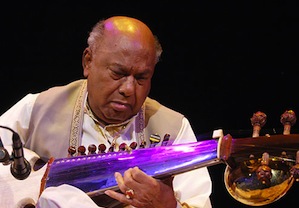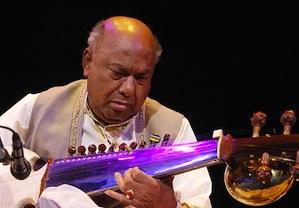
When I visited Ali Akbar Khan at his San Anselmo home in 1995, he gave me a glimpse, for the sake of journalism, of what many hundreds of students had spent decades learning in depth at his Ali Akbar College: the meaning and making of North Indian classical music.
“There are many different kinds of variety of sound,” said the man whom his students, family, and friends addressed with the honorific Khansahib. Seated on the floor beside his third wife, Mary, he embraced his majestic instrument, the sarode, with its 20-something-strings and shiny brass resonators. “Within touching one note, you can bring feeling,” Khansahib explained in idiosyncratic English. “Like if the mood is pathos, then one note can tell you, just by touching. And, of course, in the combination with two or three notes, it will become more clear. But first note at once hit your soul by sound. And then the joy notes are there, the devotion is there, heroic, strong, powerful — that feeling is there. Then also, kind of making fun, that’s also there. And all kinds of variation of rhythm, the tala. And once you learn, you can compose the same melody every day a different way. Endless, like the ocean.”
I returned eagerly seven years later to interview Khansahib and Mary at the College, situated on the western outskirts of San Rafael, about the upcoming gala celebration of his 80th birthday at the Marin Veterans Auditorium. The musical offerings there would involve distinguished former and current College faculty and guests such as tabla drummers Zakir Hussain and Swapan Chaudhuri, bansuri flute master G.S. Sachdev, kathak dancer Chitresh Das, vocalist Mala Ganguly, and a sarode duo by Khansahib’s eldest son from his first marriage, Aashish, and his and Mary’s eldest son, Alam, then 64 and 19, respectively. “It’s Big Lion and Young Lion,” Khansahib told me about his sessions with Alam, whose serene good looks reflected both his parents. “Maybe next note, he is going to put it wrong, and I am ready: At once I jump there, and he gets the idea, he gets the note, and I leave him.”
On my latest stop at the College, earlier this month, it was as though Khansahib had never left, despite his having passed away three years ago. Madina (his and Mary’s youngest child) is office manager there, Alam teaches advanced sarode and vocal classes, and Mary has assumed the directorship of the College. Alam’s younger brother Manik is helping assemble an archive of some seven thousand hours of his father’s teaching, in the form of written notation and audio and video recordings, which will be digitized and ensconced in a library, to be opened next year. The College curriculum, imparted in each session to some six dozen students ranging in age from elementary school to retirement, is still based on Khansahib’s compositions.
“Once you learn, you can compose the same melody every day a different way. Endless, like the ocean.” – Ali Akbar Khan
“My father, for the most part, composed on the spot,” recalls Alam. “So when you’re learning, you weren’t looking at sheet music, it was all just coming out of him right now. Sure, it had been influenced by the 20 or 30 years when he was learning from his father. But the thing about North Indian music is that there are all these ‘holes,’ and there’s a kind of faith involved in learning the music, that your teacher is doing the right, pure thing. It’s about playing spontaneously, but within a structure.” The structure is based around a system of ragas, built on 12-note scales of whole tones, half tones, and microtones and selected by a performer in accordance with the time of day and other factors. Ornamentation and improvisation are reflective of the player’s skill and inspiration.
Lines of Musical Heritage
Khansahib’s father, Allauddin Khan, was the musical guru and teacher of both his own son and the teenaged Ravi Shankar (whose first wife would be Khansahib’s sister, Annapurna). “He was really a major influence on the music, like Beethoven,” says Robbie Belgrade about the elder Khan, who died in 1972 at age 110, at the family homestead in Maihar, India. Belgrade, who grew up in Marin County and came to the College in 1978, after studies in Western classical music and jazz, now helps manage the College’s store in downtown San Rafael. A sometime pianist and composer, he appreciates the historical significance of his teacher’s teacher. “Beethoven’s music put demands on the piano that forced them to re-create what the piano was. Well, up until Allauddin Khan’s time, [Indian] vocal music was in its ascendancy, and instrumental music took a second tier. So what he did was combine the bass sarode and tenor sarode into a single instrument, with a greater width of expression.”
“It’s about playing spontaneously, but within a structure.” – Alam Khan
“My father played 200 instruments, and he learned Western classical music, too,” Khansahib had told me. “So he always advised me to bring these particular tones to this particular instrument [the sarode]: ‘Now play like a piano, play like a cello, like singing, like a drum.’” It was also Allaudhin Khan who urged his son to export the treasures of North Indian music to the West, where the younger Khan and his one-time brother-in-law Ravi Shankar were welcomed by violinist Yehudi Menuhin in the mid-1950s.

In 1967, Khansahib opened his school at the first of several Bay Area locations, before settling in the Marin locale that reminded him of Maihar. “Marin County was a very interesting place to be at that time,” testifies Robbie Belgrade. “There were a lot of really great musicians in my neighborhood, like The Sons of Champlin [a psychedelic rock band], there was a lot of [Indonesian] gamelan music, and my friend was way into African music.”
The new Ali Akbar College of Music proved a magnet to hippies and spiritual seekers alike, some of them camped out in the nearby woods, who were curious about North Indian classical music’s roots in Hindu religious tradition, dating back eight centuries. Drawn by classical North India’s emphasis on intonation and timing, musicians playing rock, jazz, and Western classical works also came, to supplement their university and conservatory study and enhance their performance experience.
“Khansahib used to say, ‘if you study this music, it will help with any other music you play,’ and I have to say he was totally right,” testifies Belgrade. “Since I started at the College, I’ve played Brazilian, Afro-Cuban, Arabic, flamenco, and a bit of Western classical, and I haven’t found any music that I haven’t been able to understand with the tools that I received from Indian music.” Violin was taught at the College alongside traditional Indian instruments, including the sitar, and advanced students were invited to deploy their Western instruments of choice, such as viola, cello, bass, harp, and guitar. Vocalization was a pervasive tool of Khansahib’s teaching.
“Khansahib used to say, ‘if you study this music, it will help with any other music you play,’ and I have to say he was totally right.” – Robbie Belgrade
Visitors to the College included Carlos Santana and Grateful Dead drummer Mickey Hart. Khansahib recorded and performed with jazz saxophonist John Handy, and spent several years at McGill University in Montreal, researching and recording the apparent similarities between Gregorian chant and the ancient Hindu vocal style called Dhrupad. In Europe, he collaborated with classical guitarist Julian Bream, who referred to the sarode virtuoso as “Just about the finest musician I ever met in my life.” Ken Zuckerman, one of Khansahib’s earliest American students, illuminated connections between early (Western) music and North Indian tradition by establishing a branch of the College within the Musik-Akademie of Basel, Switzerland. “It just shows again and again that all the old musics are pretty much connected,” offers Alam Khan. “They just focused on different things.”
Indian Music’s Worldwide Appeal
Alam has come to believe that in today’s world, the music of his ancestors “has no borders, it’s not confined to anything anymore. And I don’t think Indian music is in India at all. When I go to India, I see the same issues that I see here: it’s virtually gone among the youth, unfortunately.” “Over time, India got turned on its side, and now there’s a lot more Indian music in America, on the West Coast,” adds Ronnie Belgrade, who notes that the College’s store, with its copious inventory of Indian instruments and accessories and an in-house repair technician, may be the largest of its kind in the world.
The story of the College and its inception in the gharana (family tradition) of the Khans was brought to the big screen by Bay Area director Joshua Dylan Mellars in last year's artful and affecting Play Like a Lion: The Legacy of Maestro Ali Akbar Khan, now on the festival circuit. Aside from historical footage and stills, the film follows Alam on a voyage to his ancestral home in Maihar, and through his grief about his father’s passing in 2009. “I thought, ‘I don’t even know how to play myself in this film,’” Alam reflects. “But whenever I do anything, I think: the school, my father. And then my own career. By helping my own career, I help the school and my family.” He’ll be performing this coming Sunday at 2 p.m. at the Asian Art Museum in San Francisco.
The College’s winter series of concerts, showcasing faculty and advanced students at the San Rafael campus, will continue on March 3, 17, and 31. Khansahib’s birthday will be celebrated with a concert at the Freight & Salvage Coffeehouse in Berkeley on April 21, including a duo appearance by Alam on sarode and director of percussion Swapan Chaudhuri on tabla.
Despite the lamentable disappearance of vital musical categories from the Grammy Awards, Mary Khan hopes that someday Indian and Asian recordings, such as those made by her son and her late husband, will rank alongside those of Western orchestras, instrumentalists, and vocalists. “We’d like to think that Western classical musicians would want to know that this is the classical music of these other countries,” she says.
In the meantime, Mary and Alam are making good use of the Internet, both to webcast the College’s classes (you can register for both in-person and distance learning, and check on concerts, at aacm.org) and to wage a “global campaign to save the life’s work of Ali Akbar Khan,” with video testimonials from the likes of guitarists Julian Bream, John McLaughlin, Carlos Santana, and Derek Trucks (at themaestroandme.com). “This experience should never be gone,” declares Alam. “It should always be there, and with this archive, it will.”

